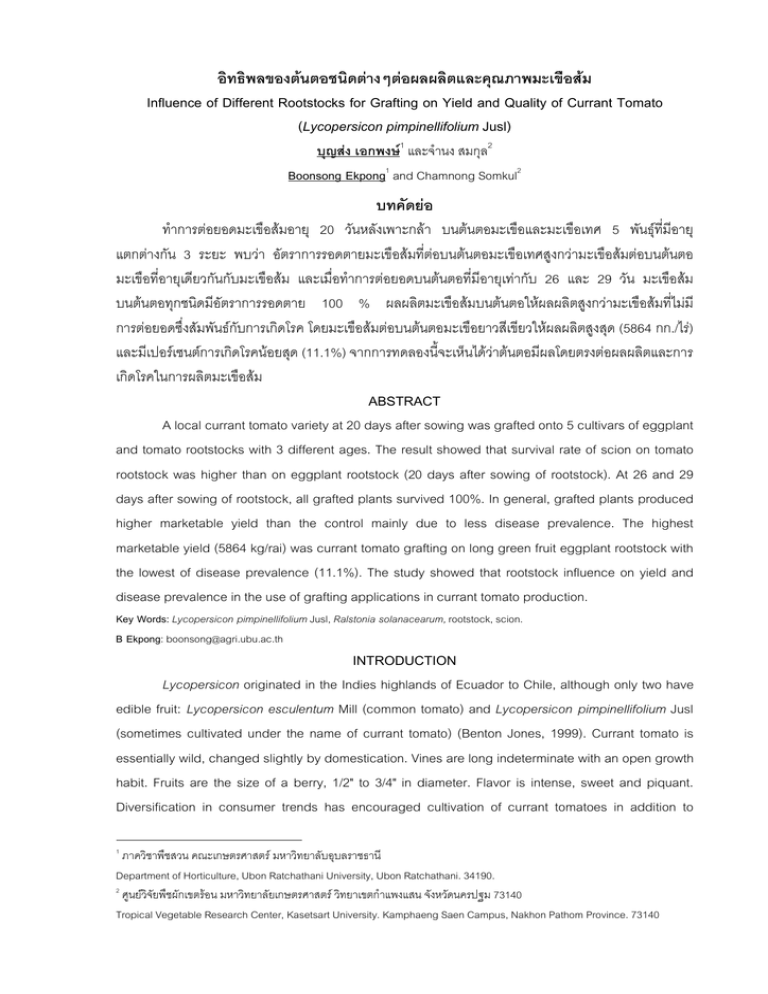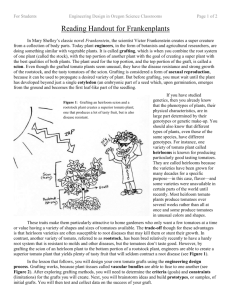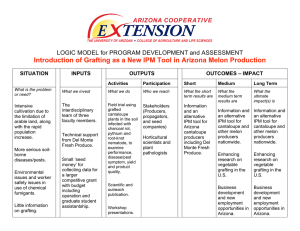อิทธิพลของต นตอชนิดต างๆต อผลผลิตและคุณภาพ I
advertisement

อิทธิพลของตนตอชนิดตางๆตอผลผลิตและคุณภาพมะเขือสม Influence of Different Rootstocks for Grafting on Yield and Quality of Currant Tomato (Lycopersicon pimpinellifolium Jusl) บุญสง เอกพงษ1 และจํานง สมกุล2 Boonsong Ekpong1 and Chamnong Somkul2 บทคัดยอ ทําการตอยอดมะเขือสมอายุ 20 วันหลังเพาะกลา บนตนตอมะเขือและมะเขือเทศ 5 พันธุที่มีอายุ แตกตางกัน 3 ระยะ พบวา อัตราการรอดตายมะเขือสมที่ตอบนตนตอมะเขือเทศสูงกวามะเขือสมตอบนตนตอ มะเขือที่อายุเดียวกันกับมะเขือสม และเมื่อทําการตอยอดบนตนตอที่มีอายุเทากับ 26 และ 29 วัน มะเขือสม บนตนตอทุกชนิดมีอัตราการรอดตาย 100 % ผลผลิตมะเขือสมบนตนตอใหผลผลิตสูงกวามะเขือสมที่ไมมี การตอยอดซึ่งสัมพันธกับการเกิดโรค โดยมะเขือสมตอบนตนตอมะเขือยาวสีเขียวใหผลผลิตสูงสุด (5864 กก./ไร) และมีเปอรเซนตการเกิดโรคนอยสุด (11.1%) จากการทดลองนี้จะเห็นไดวาตนตอมีผลโดยตรงตอผลผลิตและการ เกิดโรคในการผลิตมะเขือสม ABSTRACT A local currant tomato variety at 20 days after sowing was grafted onto 5 cultivars of eggplant and tomato rootstocks with 3 different ages. The result showed that survival rate of scion on tomato rootstock was higher than on eggplant rootstock (20 days after sowing of rootstock). At 26 and 29 days after sowing of rootstock, all grafted plants survived 100%. In general, grafted plants produced higher marketable yield than the control mainly due to less disease prevalence. The highest marketable yield (5864 kg/rai) was currant tomato grafting on long green fruit eggplant rootstock with the lowest of disease prevalence (11.1%). The study showed that rootstock influence on yield and disease prevalence in the use of grafting applications in currant tomato production. Key Words: Lycopersicon pimpinellifolium Jusl, Ralstonia solanacearum, rootstock, scion. B Ekpong: boonsong@agri.ubu.ac.th INTRODUCTION Lycopersicon originated in the Indies highlands of Ecuador to Chile, although only two have edible fruit: Lycopersicon esculentum Mill (common tomato) and Lycopersicon pimpinellifolium Jusl (sometimes cultivated under the name of currant tomato) (Benton Jones, 1999). Currant tomato is essentially wild, changed slightly by domestication. Vines are long indeterminate with an open growth habit. Fruits are the size of a berry, 1/2" to 3/4" in diameter. Flavor is intense, sweet and piquant. Diversification in consumer trends has encouraged cultivation of currant tomatoes in addition to 1 ภาควิชาพืชสวน คณะเกษตรศาสตร มหาวิทยาลับอุบลราชธานี Department of Horticulture, Ubon Ratchathani University, Ubon Ratchathani. 34190. 2 ศูนยวิจัยพืชผักเขตรอน มหาวิทยาลัยเกษตรศาสตร วิทยาเขตกําแพงแสน จังหวัดนครปฐม 73140 Tropical Vegetable Research Center, Kasetsart University. Kamphaeng Saen Campus, Nakhon Pathom Province. 73140 ordinary table tomatoes (Anonymous. 2000). Especially, in North-East Thailand, currant tomatoes are suited as ingredient in papaya salad. Currant tomatoes, like common tomatoes, are difficult to grow during the hot-wet season. Flooding, waterlogged soils, high temperature and diseases can significantly reduce yields (Black et al., 2003). Takahashi (1984) reported that 68% of failure cases in Japanese vegetable production under continuous cropping were caused by soil-borne diseases and nematodes. Since soil sterilization can never be completed, grafting has become an essential technique for the production of repeated crops of fruit-bearing vegetables grown in greenhouses. Bacterial wilt of tomato is caused by the pathogen Ralstonia solanacearum (Hayward, 1991; Gonzalez and Summers, 1994; Ma and Black, 1999). The bacterium invades and gradually blocks the vascular tissue, the food- and water-conducting vessels just beneath the epidermis, causing complete destruction of the plant, and severely limiting tomato yield. Disease resistant rootstocks are commonly used in grafting susceptible scions (Vuruskan and Yanmaz, 1990; Marsic and Osvald, 2004). This method provides a way for the continuous production of one crop in one preferred area. Grafting of tomato scions onto bacterial wilt resistant eggplant rootstocks has been demonstrated at AVRDC to protect the plants from damage caused by waterlogged soils and bacterial wilt (Black et al., 2003). The influence of grafting on the yield of currant tomato has not been precisely studied as yet in Thailand. The aim of this research was to examine the effects of different grafting rootstocks on the success of grafting and yield of currant tomato. MATERIALS AND METHODS The experiment was conducted at the Faculty of Agriculture, Ubon Ratchathani University (latitude: 15° 07' N, longitude 104° 54' E, 130 m asl), from September 2005 to April 2006. The site is an upland sandy low humic soil (Roi-et soil series). Soil samples to 10 cm, taken at sowing in December 2005, was acidic (pH 4.8), and low in organic matter (0.9 %), N (0.05%), P (11.0 ppm) and K (18 ppm). Prior to cultivation, the site has been planted with tomato for 5 years. Local currant tomato was used as scion and 3 eggplant varieties [long green (LG), long purple (LP) and round purple (RP) fruit type], 2 varieties of common tomato tolerant to bacterial wilt (TM 01 selected at Ubon Ratchathani University and CL-6046BC3F2-51-0-20-5-15-14-1 from AVRDC) were used as rootstocks. The seeds of scion were sown on November 18, 2005 and the seeds of rootstock were sown at 0, 6, 9 and 12 days earlier than those of the scion. Pin grafting, as described by Lee et al. (1998), was applied on December 8, 2005 at four leaf stage (20 days after sowing), thus, rootstocks had different ages of 20, 26, and 29 days, respectively. The grafting procedure is shown in Figure 1. Figure 1 Pin grafting procedure. The grafted plants were allowed to heal and acclimatise in a plastic tunnel covered with 0.2 mm-thick, UV-resistant polyethylene sheet to maintain moisture that evaporates from a water-filled floor pan. The chamber was covered with shade nets to reduce light penetration. The over-the-top shade nets further reduced light penetration and allowed good air circulation to minimize heat buildup. The grafted plants were kept at 28-32ºC and with more than 85% relative humidity for five days of healing, which promoted the survival rate. Some grafted seedlings wilted initially but became upright within three days. Six days after grafting, the hardening process was started by peeling away the top layer of shading nylon net material and the water drained out of the floor pan. The plastic-covered door of the chamber was opened but the screen door was kept closed to prevent insect infestation. These conditions were maintained for five days. The grafted plants were moved out the chamber and placed into a screen-house for ten days for further development and hardening to make them suitable for transplanting. Successfully grafted plants (Figure 2) were planted on December 28, 2006 into plots where bacterial wilt disease was known to occur in a previous crop. Plot size was 1.53 m x 5.0 m. Spacing was 0.80 m between rows and 0.50 m between plants within the row. The experiment was laid out in randomized complete block design with six treatments (scion-5 rootstock combinations and nongrafted plants) with three replicates. Normal cultural practices for the experiment were followed for irrigation, fertilization and pesticide application. Harvest was made once per week when the fruits reached the color breaking stage. Harvesting began on March 15, 2006 and continued until April 12, 2006. The following measurements were recorded: (a) hypocotyl diameter at grafting, (b) number of survival plants at transplanting date, (c) fruit yield (g plant-1), (d) total number of fruits plant-1, (e) fruit diameter, (f) fruit quality, and (g) percentage of plants infested. Data were analyzed using analysis of variance to examine treatment effects, and means were separated by Duncan's multiple range tests at P≤0.05. Figure 2 Successfully grafted plants. RESULTS AND DISCUSSION 1. Stem diameter and survival rate of grafted plants Hypocotyl diameter was measured and the results are presented in Table 1. The highest diameter was recorded in UB 01 (2.7 mm) while eggplant (LG) had the smallest (1.8 mm). The greatest difference in rootstock and scion diameters in grafting was that between LG, LP, RP and CT, at -0.07 mm. The correlation between hypocotyl diameter and survival rate was highly significant (r= 0.80).This result is similar to the findings of Oda et al., (1993 and 1994) in cucumber showing that a smaller difference in hypocotyl diameter between rootstocks and scion may increase the chances for vascular bundles of the scion and rootstock to come into contact and increase survival rate. Higher survival rate was found in tomato rootstocks compared to that in eggplant at 20 days of rootstock seedlings (Table 1). Thereafter, survival rate was not significant. This result showed that there was no incompatibility between the rootstock and scion plants. It showed that hypocotyl diameter might be the main factor for success in grafting. This confirmed the findings of Black et al. (2003) that stem diameters of the rootstock and scion must be similar for successful grafting. In this study, the seedlings of tomato rootstocks grew faster than eggplant rootstocks. For success in pin grafting, seeds of tomato rootstock and scion should be sown on the same day while those of eggplant rootstock should be sown 6 days before the scion seeds. Table 1 Hypocotyl diameter and survival rate of grafted plants. Rootstock Diameter of hypocotyl and survival rate (%) RHD- Survival 29 RHD- Survival 20 RHD- Survival 26 days SHD1 rate days SHDa rate days SHDa rate LG 0.13c -0.07 87b 0.17d -0.03 100 0.18d -0.02 100 LP 0.13c -0.07 91b 0.18d -0.02 100 0.20c 100 RP 0.13c -0.07 91b 0.20c 100 0.23b +0.03 100 TM01 0.19a -0.01 100a 0.25a +0.05 100 0.27a +0.07 100 CL 0.17b -0.03 100a 0.21bc +0.01 100 0.25a +0.05 100 CT 0.2 0.2 0.2 F-test ** ** ** ** C.V.(%) 6.7 4.7 4.9 8.2 Means in each column followed by the same letters are not significantly different by DMRT. ** Significant at probability level of 0.01; ns = not significant. 1 RHD: rootstock hypocotyl diameter, SHD: scion hypocotyl diameter 2. Yield and yield components Plants grafted on different rootstocks differed significantly from non-grafted plants with respect to number of fruits/plant, yield/plant and marketable yield/rai (Table 2). Table 2 Effect of different rootstocks on yield, fruit characteristics and disease prevalence in tomato. Plant Fruit Number Weight/ Yield/ Marketable pH TSS Fruit plant yield Rootstock diameter of (°Brix) infested (g) (kg/rai) (%) (mm) fruits/plant (g) LG 19.1 288.8cd 6.5 1649.3b 5864.1a 4.8 3.95 11.1 LP 19.2 228.3bc 7.3 1525.6b 4727.7ab 4.9 3.98 22.2 RP 19.3 306.5d 7.4 1705.2b 4168.1b 4.9 3.97 38.9 TM01 18.6 251.6cd 6.7 1785.4b 4364.3b 4.8 3.93 38.9 CL 18.6 198.2b 7.1 1396.7b 3414.0b 4.9 3.95 38.9 Un-grafted 18.4 71.7a 6.5 295.3a 98.4c 4.9 3.96 91.7 F-test ns ** ns ** ** ns ns C.V. (%) 4.5 17.2 14.3 20.9 23.6 2.1 3.2 Means in each column followed by the same letters are not significantly different by DMRT; ** Significant at probability level of 0.01; ns = not significant. The maximum marketable yield was recorded in plants grafted on LG rootstock (5864.1 kg/rai). The highest disease prevalence was recorded in non-grafted plants as compared to other grafted ones with LG was having the highest resistance to bacterial wilt coming from the soil. The fact that the grafted plants produced better results than non-grafted ones when grown on infested soils indicates the potential economic value for a grower of growing grafted plants (Vuruskan and Yanmaz, 1990; Black et al., 2003). However, grafting had no significant effect on fruit diameter, weight, pH, and percent of soluble solid. Considering lower disease prevalence and high yield, eggplant (LG) could be considered as a good rootstock of currant tomato production. CONCLUSION Eggplant rootstock (LG) performed better for yield and yield components on currant tomato than those of tomato rootstocks and non-grafted plants when grown on soil infested with bacterial wilt. For success in pin grafting, tomato rootstock and scion seeds should be sown on the same day, while eggplant rootstock seed should be sown 6 days before sowing of scion seeds. ACKNOWLEDGEMENTS We would like to thanks to the Office of Experimental Field and Central Laboratory, Faculty of Agriculture, Ubon Ratchathani University, for providing all facilities used in this study. Ours thanks also to Assoc. Prof. Dr. Tuantong Jutagate and Mr. Efren Altoveros for his support in statistical analysis and reviewing this manuscript. REFERENCES Anonymous. 2000. Lycopersicon pimpinellifolium. Available source: http://www.ibiblio.org/pfaf/cgibin/arr_html?Lycopersicon+pimpinellifolium. October 11, 2006. Black, L.L., D.L. Wu, J.F. Wang, T. Kalb, D. Abbass and J.H. Chen. 2003. Grafting tomatoes for production in the hot-wet season. Available source: http://www.avrdc.org/LC/tomato/grafting.pdf. October 11, 2006. Benton Jones, J. Jr. 1999. Tomato plant culture in the field and greenhouse. CRC Press LLC. Florida 33431. Gonzalez, W. G. and W. L. Summers. 1995. A Comparation of Pseudomonas solanacearumresistance Tomato Cultivars as Hybrid Parents. J. Amer. Hort. Sci. 120(6): 891-895. Hayward, A. C. 1991. Biology and epidemiology of bacterial wilt caused by Pseudomonas solanacearum. Annu. Rev. Phytopathol. 29: 65-78. Lee, J.M., H.J. Bang, and H.S. Ham (1998). Grafting of vegetables. J. Japan. Soc. Hort. Sci. 67(6): 1098-1104. Ma, C.M. and L.L. Black. 1999. Program II Year-round vegetable production systems. Available source: http://www.avrdc.org/pdf/99proj4.pdf. October 11, 2006. Marsic, N.K. and J. Osvald. 2004. The influence of grafting on yield of two tomato cultivars (Lycopersicon esculentum Mill.) grown in a plastic house. Acta Agriculturae Slovenica. 83(2) 243 – 249. Oda, M., K. Tsuji and H. Sasaki. 1993. Effect of hypocotyl morphology on survival rate and growth of cucumber seedling grafted on Cucurbita spp. JARQ, 26: 259-263. Oda, M., K. Tsuji, K. Ichimura and H. Sasaki. 1994. Factors affecting the survival of cucumber plants grafted on pumpkin plants by horizontal grafting at the hypocotyls level. Bull. National Research Institute for Vegetables, Ornamental Plants and Tea 9: 51-60. Takahashi, K. 1984. Injury by continuous cropping in vegetables: various problems in the cultivation using grafted plants. Yasaishikenjo Kenkyu Shiryo 18: 87-89. Vuruskan, M.A. and R. Yanmaz. 1990. Effects of different grafting methods on the success of grafting and yield of eggplant/tomato graft combination. Acta Horticulturae. 287: 405-409.

